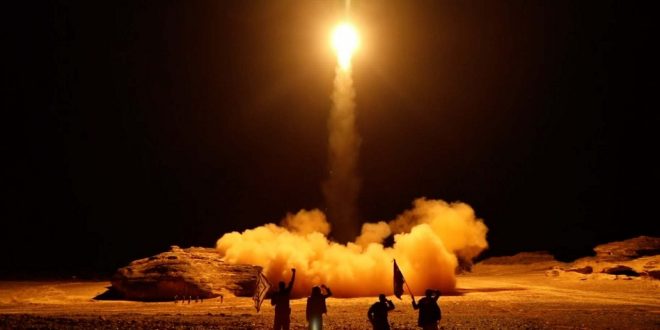Alwaght- It has been a long time that the control of the Yemen war slid out of the control of the Saudis and Riyadh desperately has been seeking a way out of the quagmire it is stuck in.
Five years on, Saudi regime’s defeat ins definite and the scales are tipped n favor of the Yemenis. The defining feature of this defeat is the increase of the vulnerability of the Arab kingdom to Yemeni strikes.
For example, over the past month, the routes of oil transfer in the western ports of the kingdom on the Red Sea coasts through to the western provinces experienced unprecedented insecurity.
The attacks targeted at least three Saudi-rented oil tankers that carry petroleum products from the country’s eastern port of Yanbu to the southern ports of Jeddah and Shaghigh, with the Saudis failing to take effective measures to protect their marine trade and oil shipments.
The existence of such a Saudi security loophole in the Saudi military defense in the face of growing Yemeni Ansarullah capabilities causes the Yemeni movement to give ultimatums for their demands with more confidence as Saudi Arabia is severely reliant on the oil incomes amid financial crisis it is grappling with.
On Sunday, the Foreign Minister of Sana’a-based National Salvation Government Hesham Sharaf Abdullah warned the Saudi-led coalition that if it does not review its policy of impoverishment of the Yemeni people, Ansarullah will launch retaliatory strikes on the ports of the aggression countries.
“Sana’a will not stay indifferent as some think. If the blockade on Yemeni ports continues, the enemy’s ports will not remain immune to strikes.
Saudi economic arteries within Yemen missile range
2019 witnessed important changes in Yemen war equations as the country initiated its waves of crippling missile strikes, dubbed Operation Deterrence”, against strategic targets in the Saudi depth. The first phase was launched on August 17, when missiles and drones of the revolutionary forces of Yemen carried out an attack on Al-Shayba oilfield operated by Aramco oil giant in southwestern Saudi Arabia and only 10 kilometers from the Emirati borders.
The second phase came on September 14, 2019, when 10 drones launched air raids on Aramco oil processing facilities in Abqaiq and Khurais east of the kingdom, shutting down half of the kingdom’s oil production capacity. The aftermath of the operation disturbed Saudi Arabia for several months, destroying the Crown Prince Mohammed bin Salman’s plans to sell part of the Aramco stake to raise the cash much needed for economic recovery. The third and fourth phases came in February and June 2020, targeting Aramco, military, and intelligence positions.
The Saudi failure to counter Ansarullah’s missile power is now also seen along with the kingdom’s failure in the asymmetrical warfare in the sea. This would make the Yemeni reciprocal strikes more painful as the Saudis are heavily reliant on the ports that play a key role in the country’s foreign trade.
To understand the case, we can look at the enormous investment Saudi Arabia made in the past years on its ports. In 2014, it held its first marine conference in the coastal city of Dammam to highlight its commitments to expand its maritime sector. It so far held another three maritime sector conferences.
One of the steps toward this aim was the King Salman Global Maritime Industries Complex. A project launched with a joint investment of Aramco, National Transportation Authority (Bahri), Hyundai Heavy Industries, and Lamprell engineering company. According to a report published in 2018 by Saudi Investment Bank and Jadwa Investments, the project will be complete by 2022.
According to Saudi officials, the project, with a 45 billion Saudi riyal ($11.9) investment, is planned to make 64 billion riyals ($17) annually, boost GDP and trade, and create 80,000 direct and indirect jobs by 2030.
The key Saudi port is Jeddah port which is also one of the most important ports in the whole region. It is located on the Red Sea coast and the largest port on this sea’s coasts. Over 800 kilometers of distance separates Jeddah port from the Ansarullah-administered regions in Yemen.
Dammam is the second largest port of the kingdom, located on the Persian Gulf coasts. Home to 56 multifunction container cranes and a large number of docking and fishing piers, Dammam port is another key port, with over 1,000 kilometers from Sana’a.
Al-Jubail port with 1,500 kilometers, Port of Jiran with 230 kilometers, and Port of Shaghigh with 500 kilometers of distance from Yemen are the other important Saudi ports.
Marking these ports as potential targets while they have a long distance from Yemen demonstrates Ansarullah’s substantial military and defense capability boost in the face of the aggression countries, a major change in the war equations, and the fact that Saudi Arabia has no choice but yielding to Sana’a demands for end of the five-year inhumane blockade on Yemen.
 WILAYAH NEWS VOICE OF THE GLOBAL AWAKENING
WILAYAH NEWS VOICE OF THE GLOBAL AWAKENING






